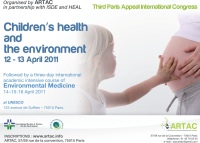- you are on : ISDE
- General objectives
- Cancer
Cancer
Cancer is a major cause of mortality in the world : it caused 12 million cases and 7.9 million deaths (approximately 13% of the global death rate) in 2007. Lung cancer, stomach cancer, liver cancer, colon cancer and breast cancer cause the main part of deaths due to cancer in the world. According to WHO, worldwide, cancer-related deaths should continue to increase, with approximately 12 million deaths by 2030. However, roughly 30% of these deaths could be avoided immediately! Cancer results from the interaction of individual genetic factors with three categories of outside carcinogenic agents : physical agents, such as ultraviolet rays, ultrafine particles and ionizing radiations ; chemicals, such as asbestos, tobacco smoke components, aflatoxin (food contaminants), numerous CMR (Carcinogenic, Mutagenic and/or Reprotoxic) organic substances and heavy metals such as arsenic (drinking water pollutant), cadmium, chromium or nickel ; and finally carcinogenic infectious agents, such as some viruses, bacteria or parasites. IARC researchers have recently used the European data base listing cancer cases in children and teenagers to assess its development in terms of incidence and survival. A study [LINK!] which analyzed 113,000 childhood cancer cases and over 18,000 cancer cases in teenagers in the ‘70s, ‘80s and ‘90s has shown that in Europe, cancer incidence rates increased by approximately 1% each year in children and by 1.5% in teenagers. Increases have been recorded for just about all types of childhood cancer; whereas for teenagers, increases have mostly affected lymphomas, soft tissue sarcomas, germ cell tumors and central nervous system (CNS) tumors. These results clearly show an increase in cancer incidence during childhood and adolescence in the last decades, and this trend has been gathering pace recently.
Cancer is an avoidable disease. The challenge lies in shifting human will towards primary prevention : since the American declaration of “ war against cancer “ in 1971, we have never fought the real foe : carcinogenic agents. A decrease in cancer incidence will be obtained by eliminating carcinogens in the air that we breathe, in the water that we drink, in the food that we eat, and in the chemicals that we use in our workplaces. A healthy environment free from any cancer-causing substance should be what we will pass on to our children.
